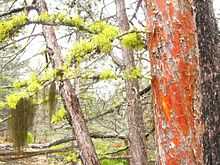Cupressus bakeri
| Cupressus bakeri | |
|---|---|
 | |
| Conservation status | |
| Scientific classification | |
| Kingdom: | Plantae |
| Division: | Pinophyta |
| Class: | Pinopsida |
| Order: | Pinales |
| Family: | Cupressaceae |
| Genus: | Cupressus |
| Species: | C. bakeri |
| Binomial name | |
| Cupressus bakeri Jeps. | |
 | |
| Natural range | |
Cupressus bakeri, the Modoc cypress, Siskiyou cypress or Baker cypress, is a species of cypress native to a small area in the western United States, located in California and Oregon.
Distribution
Cupressus bakeri grows in a restricted area of Northern California: in Siskiyou, Modoc, Shasta, Plumas and Tehama Counties; and in southwest Oregon: very localized in Josephine and Jackson Counties. [1]
It is usually found in small, scattered populations, not in large forests, at altitudes of 900–2,000 metres (3,000–6,600 ft). This includes locales in the Modoc Plateau, southern Cascade Range, Klamath Mountains, and northern Sierra Nevada. [2] It is slow-growing in the wild, and is mostly restricted to sites difficult for plant growth, on serpentine soils and on old lava flows. Its tolerance of these sites enables it to avoid competition from much faster-growing trees.

Description
Cupressus bakeri is a medium-sized evergreen tree with a conic crown, growing to heights of 10-25 m (exceptionally to 39 m), and a trunk diameter of up to 0.5 m (exceptionally to 1 m). The foliage grows in sparse, very fragrant, usually pendulous sprays, varying from dull gray-green to glaucous blue-green in color. The leaves are scale-like, 2-5 mm long, and produced on rounded (not flattened) shoots. [3]
The seed cones are globose to oblong, covered in warty resin glands, 10-25 mm long, with 6 or 8 (rarely 4 or 10) scales, green to brown at first, maturing gray or gray-brown about 20–24 months after pollination. The male cones are 3-5 mm long, and release pollen in February-March. [4]
The cones often remain closed for several years, only opening after the parent tree is killed in a wildfire, thereby allowing the seeds to colonize the bare ground exposed by the natural fire.
Conservation
Fire suppression policies of the past decades have severely limited reproduction of this fire dependent species. It is listed as a vulnerable species. [5]
See also
References
- ↑ http://plants.usda.gov/java/profile?symbol=CUBA&mapType=nativity&photoID=cuba_001_avp.tif USDA
- ↑ http://ucjeps.berkeley.edu/cgi-bin/get_cpn.pl?21396 Jepson
- ↑ http://www.pinetum.org/PhotoJEFFbakeri.htm pinetum.org: Photos, trees
- ↑ http://www.pinetum.org/cones/CUbakeri.jpg pinetum.org: Photos, cones
- ↑ Conifer Specialist Group (2000). Cupressus bakeri. 2006. IUCN Red List of Threatened Species. IUCN 2006. www.iucnredlist.org. Retrieved on 5 May 2006. - Listed as Vulnerable (VU B1+2bcd v2.3)
External links
- Jepson Manual Interchange: Cupressus bakeri
- USDA Plants Profile - Cupressus bakeri (Modoc cypress)
- Cupressus bakeri - Photos Gallery
- Gymnosperm Database: Cupressus bakeri
| Wikimedia Commons has media related to Cupressus bakeri. |
